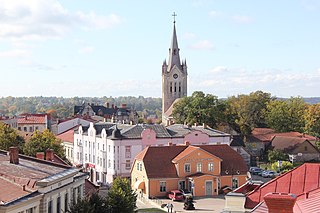
Cēsis, is a town in Latvia located in the northern part of the Central Vidzeme Upland. Cēsis is on the Gauja River valley, and is built on a series of ridges above the river, overlooking the woods below. Cēsis was selected to be one of the candidate cities for the title of the European Capital of Culture 2014.

Tukums is a town in Latvia and serves as the administrative center of Tukums Municipality. It is located in the eastern part of the historical region of Courland, and with more than 16,000 inhabitants Tukums is the 13th largest settlement in Latvia. It is also an important railroad junction, connecting the town with Riga, Jelgava and Ventspils. It has two railway stations — Tukums I and Tukums II.

Rēzekne is a state city in the Rēzekne River valley in the Latgale region of eastern Latvia. It is called The Heart of Latgale. Built on seven hills, Rēzekne is situated 242 kilometres east of Riga, and 63 kilometres west of the Latvian-Russian border, at the intersection of the Moscow – Ventspils railway and Warsaw – Saint Petersburg Railways. It is the 7th largest city in Latvia.
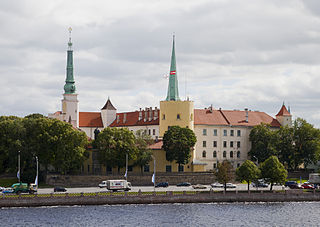
Riga Castle is a castle on the banks of River Daugava in Riga, the capital of Latvia. The castle was founded in 1330. Its structure was thoroughly rebuilt between 1497 and 1515. Upon the castle's seizure by the Swedes, they constructed spacious annexes in 1641. The fortress was continually augmented and reconstructed between the 17th and 19th centuries. Sometime in the 1930s, some renovation work was done by architect Eižens Laube. The Latvian government declared the castle its residence in 1938. Today it is the official residence of the President of Latvia as well as home to several museums.

Semigallia, also spelt Semigalia, is one of the Historical Latvian Lands located to the south of the Daugava river and to the north of the Saule region of Samogitia. The territory is split between Latvia and Lithuania, previously inhabited by the Semigallian Baltic tribe. They are noted for their long resistance (1219–1290) against the German crusaders and Teutonic Knights during the Northern Crusades. Semigallians had close linguistic and cultural ties with Samogitians.

Bauska Castle is a complex consisting of the ruins of an earlier castle and a later palace on the outskirts of the Latvian city of Bauska.
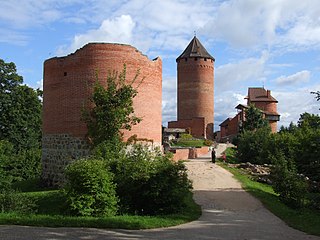
Turaida Castle is a recently reconstructed medieval castle in Turaida, in the Vidzeme region of Latvia, on the opposite bank of the Gauja River from Sigulda.
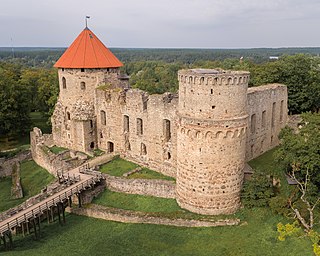
Cēsis Castle is one of the most iconic and best preserved medieval castles in Latvia. The foundations of the castle were laid 800 years ago by the Livonian Brothers of the Sword. The most prosperous period Cēsis Castle experienced was during its next owners, the Teutonic Order. It became one of the key administrative and economic centers of the Teutonic Order in Livonia and was a seat of Landmeister in Livland. The first serious damage was done to the castle during the Livonian War, when it was besieged by the army of Ivan the Terrible. In the course of the siege of 1577 approximately 300 people within the castle committed mass suicide by blowing themselves up with gunpowder. Cēsis Castle was still in use during the following century but it fell into disuse after the Great Northern War. Today the castle is the most visited heritage site in Cēsis and one of the 'must see' destinations in the Baltic states.

Kandava is a town in Tukums Municipality, in the Courland region of Latvia. It had a population of 3,656 people as of January 2020.

Jaunpils Castle is a castle in Jaunpils Parish, Tukums Municipality in the Semigallia region of Latvia. More of a manor house than properly a fortified castle, it has now been converted into a hotel.

Lielstraupe Castle is a castle in Straupe Parish, Cēsis Municipality, in the Vidzeme region of Latvia. It was originally built by the von Rosen family in the 13th century and the village of Straupe began to develop around the castle in the 14th century, a large tower was added around 1600 and expropriated soon after. Latter reacquired and remodeled into the baroque style in the 18th century and remained inhabited until being expropriated from Hans von Rosen in 1939.

Aizpute Castle is a Livonian Order castle in the town of Aizpute in the historical region of Courland, in western Latvia. It was heavily damaged during the Second Northern War (1655–1660). Since 1998, the castle ruins are a Latvian historical monument.

Lielvārde Castle is a castle in Lielvārde, a town in Ogre Municipality in the Vidzeme region of Latvia.The castle was built at the steep bank of Daugava River, overseeing this important medieval waterway, before 1248 by Albert of Buxthoeven, an archbishop of Riga. During the Livonian War, Lielvārde Castle was destroyed by Russian troops in 1579. Its ruins are conserved up to the level of the second floor.

Sigulda Medieval Castle ruins are located on the edge of the Gauja valley in Latvia. The original castle was built in 1207 as a castellum type fortress, later rebuilt into a convent type building. The residence of the Land Marshal of the Livonian Order since 1432.
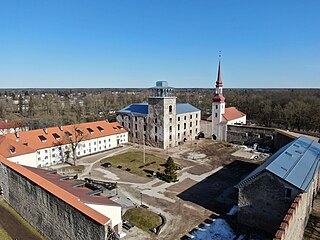
Põltsamaa Castle, also Põltsamaa Order Castle,, is a castle in Põltsamaa, Jõgeva County, in eastern Estonia.
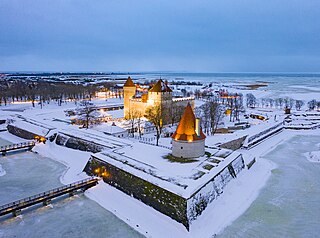
Kuressaare Castle, also Kuressaare Episcopal Castle, is a castle in Kuressaare on Saaremaa island, in western Estonia.

Krustpils Castle is a castle in Jēkabpils, Latvia. It is one of the best preserved medieval castles in Latvia. During the Russo-Turkish War (1877–1878), Turkish prisoners of war were held here, many of whom later settled here permanently. Here the Latgale artillery regiment was located. During the Second World War infirmary of the German army was located here. A military hospital of the Red Army was placed here after August 1944.

Dundaga Castle is a medieval castle in Dundaga, in the Talsi Municipality in the Courland region of Latvia. Latvia considers Dundaga Castle to be a monument of archaeological and of architectural importance.

Rauna Castle ruins are located in the village of Rauna in Rauna Parish, Smiltene Municipality, in the Vidzeme region of Latvia. The castle was the principal residence of the Archbishopric of Riga, and was visited each year by the Archbishop and his entourage. During the 16th century, it was greatly expanded and a settlement developed around the castle. It was first demolished in the 17th century, but the towers and parts of the castle still remain.




















